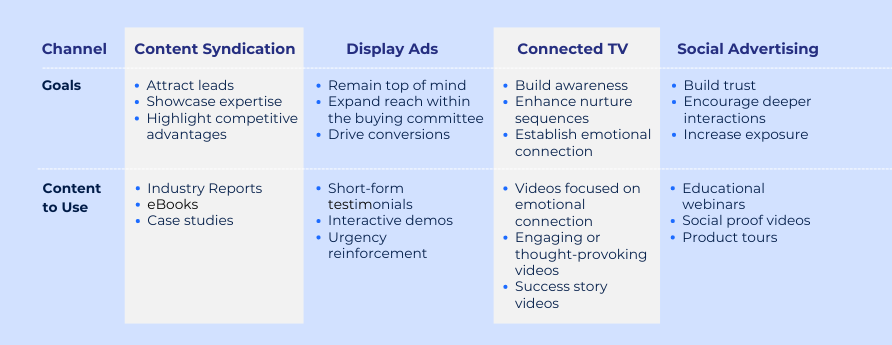
According to LinkedIn’s 95-5 Rule, only a small percentage of potential B2B buyers are actively seeking solutions at any given time. With this data suggesting that only 5% of target accounts are in-market to purchase a solution, it’s become increasingly important for marketers to seek strategies that target the 95% of accounts that aren’t ready to buy today but will be in-market sometime in the future.
The problem is that marketers must often make hard tradeoffs between their brand and demand activities. As a result, brand-building typically takes a back seat to demand generation, as marketers prioritize short-term initiatives to achieve quarterly revenue objectives.
But the days of “quick wins” are dwindling. B2B buyers are taking longer to commit to purchases and often end up selecting a vendor from their day-one shortlist. These market conditions make a stronger case for balancing your brand and demand activities to capture the early attention of decision-makers and keep your solution top of mind throughout the entire buying journey. Emerging channels like Connected TV (CTV) offer an opportunity to get in front of buyers before they initiate the buying process to gain a coveted spot on that day-one vendor shortlist. Nearly half of all U.S. homes already watch CTV every day. With that number expected to grow to 87% by 2025, CTV is a critical channel to add to your unified, multi-channel strategy in 2024. Here’s why.
What Is Connected TV (CTV)?
Connected TV (CTV) is a category of over-the-top (OTT) streaming devices that connect to or are embedded into a television to support video content streaming. This encompasses both Smart TVs and the devices connected to TVs, like sticks and gaming consoles, that give viewers access to a variety of streaming services like Netflix and Hulu.
As more people cut their cable cord in favor of these streaming services, CTV has increasingly become a powerful channel to capture buyer attention. In 2022, Nielsen reported that CTV outperformed cable and broadcast TV to become the dominant form of entertainment on U.S. TV screens. And according to the Interactive Advertising Bureau (IAB), CTV is one of the fastest-growing channels in digital video ad spend—up 22% in 2022, and 37% faster than short-form video from web and app-based publishers
What Is CTV Advertising?
Connected TV (CTV) advertising is a marketing channel that delivers targeted video ads through internet connected devices. CTV ads appear across streaming platforms during TV shows, movies, or other video content. Unlike traditional TV advertising, CTV advertising can be tailored to specific IP addresses to identify viewers, making it easier to target buying personas.
Watch an example of Salesforce’s CTV ad

5 Reasons to Include CTV Advertising in Your Marketing Strategy
Faced with larger buying committees, longer sales cycles, and a more complex decision-making process, marketers must reach buyers before they even know they have a problem to solve to facilitate group agreement and move the deal forward. A unified brand-to-demand approach focused on building relationships with prospects before they’re ready to buy allows you to deliver a consistent personalized experience that increases awareness and fuels pipeline growth and revenue.
Here are five reasons why a brand-to-demand strategy maximizes your exposure to buyers so that your brand stays top-of-mind throughout the decision-making process, and why CTV advertising is key to bringing this strategy to life.
1. Reach More Digital and Self-Guided Buyers
Buyers are becoming more independent when exploring solutions to their business problems. With Forrester research indicating that 90% of the purchase process is completed before buyers contact a vendor, it’s up to marketers to guide buying committee members toward a decision.
Forrester reported in their Q4 2021 B2B Advertising Trends Survey that half of its participants read, watch, and listen to business topics and trends for more than four hours per week, with 41% spending four or more hours educating themselves about specific vendor products or solutions during the last purchase decision. The same survey found that 30% of VP and other functional leaders spend over seven hours a week with business media, with 71% of VPs and leaders educating themselves on vendors for about four hours per week when they need to decide on a purchase.
This level of independent research is why it’s important to reach the 95% of “out-of-market” buyers before they initiate the research process. You need to build brand recognition and trust through a brand-building strategy, and then balance those efforts with demand capture activities to close those deals and win a lifetime customer. The frequent use of CTV offers the earliest opportunity to get in front of decision-makers, which adds to the likelihood of being included in initial solution research and the day-one vendor lists.
2. Increase Your Opportunities for Personalization
B2B buyer personalization has become a critical component of a successful ABM strategy. Buyers no longer want more personalized buying experiences, they demand it.
When it comes to brand-building, data is key to not only understanding which accounts are moving in-market for a solution, but also identifying the buying committee members within these accounts who will research and engage with relevant content and messaging. Each committee member comes to the decision table with separate concerns and pain points. You need to reach these buyers with personalized experiences to stand out.
CTV’s reliance on IP addresses to identify viewers makes it easier to target specific audiences, buying personas, and demographics. This allows you to deliver different ads and messaging per home based on a viewer profile. Google recently revealed that it will no longer deprecate cookies, but this decision still carries significant implications for those dependent on Chrome’s cookies for data. As online advertising becomes more complex due to new cookie policies and an increase in user privacy laws, most experts expect CTV to grow in popularity as more marketers shift funds to it and other cookieless marketing strategies.
3. Drive Higher Engagement Across the Entire Sales Cycle
To stay top-of-mind throughout the decision-making process, it’s important to surround the buying committee across the entire sales cycle. And while CTV advertising is a powerful channel on its own, its impact is enhanced when used as part of a unified multi-channel account-based strategy. Connected TV fits into multi-channel ABM by helping drive higher engagement across the entire sales cycle. It increases your reach by continuously serving content and messaging that empowers decision-makers at every stage of the funnel with information and reinforces your brand’s reputation as a partner and solution to trust.
CTV can be integrated alongside other marketing channels to create a comprehensive, always-on ABM approach that guides buyers across the entire buyers’ journey. Consider integrating CTV with:
- Content syndication. Content syndication allows you to republish your original content (blog posts, articles, infographics, and videos), on third-party sites, allowing you to reach buyers beyond your own channels.
- Display ads. Leverage display ads to engage and retarget buyers with creative, eye-catching visual ads, that capture attention and enhance solution visibility.
- Paid social campaigns. Running paid social campaigns on LinkedIn, the largest B2B social network, allows you to deliver ads where your buyers are most likely to see them.
Consider how each channel fits into your strategy and leverage thoughtfully based on the needs of each buyer persona and the goal you want to achieve. As the sole ABM solution that unifies these primary channels, Madison Logic empowers you to activate comprehensive full-funnel, multi-channel ABM campaigns that gain complete visibility into campaign performance.

4. Gain Better Metrics for Real-Time Measurement and Optimization
Understanding how early-stage accounts interact and engage with content is crucial for measuring and optimizing your brand-building activities. When it comes to measuring brand-to-demand activities, many B2B marketers struggle with demonstrating ROI for their efforts. Most of the time, this is because they focus on the wrong metrics. When measured as part of a unified multi-channel strategy, CTV provides an opportunity for marketers to look at higher value forms of measurement that focus on buyer trends and behaviors over time, which will make your marketing motions more flexible and proactive versus reactive.
Marketers increasingly need to move away from click-based attribution and instead look at higher-value forms of ABM measurement that look at trends and the correlation of behaviors over time. In Forrester’s Q4 2021 B2B Advertising Trends Survey, the top three buyer behaviors in response to advertisements were unrelated to a “click-through” action. Instead, buyers are researching the solution on a search engine, visiting the website without clicking the ad, or sharing the ad’s primary messaging with colleagues.
With a fuller picture of the entire buyer’s journey, multi-channel strategies allow you to measure engagement over time and identify optimization opportunities as needed. By linking your CTV engagement to your entire multi-channel ABM strategy, you can understand how your content performs in the early stages of the sales cycle. This allows you to evaluate how your brand and awareness efforts are driving and linking to your demand generation strategy. More importantly, this visibility makes it easier to uncover optimization opportunities to generate more revenue, improve ROI, and increase win rates through more relevant and personalized marketing content.
5. Future-Proof Your B2B Marketing
The future is here—has your strategy caught up? As buyer preferences constantly evolve, and new advertising channels like Connected TV gain popularity, staying competitive in the market and top of mind with buyers requires adapting to trends.
According to Forrester research, millennial buyers aged 25-44 are increasingly shifting into purchase decision-making roles and now make up three-fourths of business buying teams. As the next generation of B2B decision-makers rises, emerging digital channels like CTV will be a strategic channel to effectively engage and reach these buyers. According to a recent Prosper Insights & Analytics survey, CTV has emerged as one of the most popular channels among these younger generations, with 92% of Gen-Z and 89% of millennials watching at least one free streaming service such as YouTube or Peacock.
By embracing CTV now, you can future-proof your marketing efforts and gain a crucial edge over the competition, ensuring you remain one step ahead. Future-proof means not only adapting to new trends, but also continuously refining your approach to meet the changing preferences of the modern millennial and Gen-Z buyers.
Here are some tips to help you get started with a CTV campaign now:
- Run a pilot program. Test CTV’s effectiveness with a pilot campaign. Implement an ABM CTV pilot to evaluate its impact and adjust your strategy based on insights.
- Invest in video creative: Consider investing in compelling, high-quality video content that could translate over to CTV. Focus on visuals, storytelling, and customer testimonials to create video content that captures attention and drives engagement. You can also repurpose existing assets you may have on your website or social media.
- Monitor and adapt: Stay updated on trends relating to CTV advertising and buyer behavior. Adapt your strategy to leverage new opportunities and technologies as they arise.
Challenges with CTV
As with any B2B strategy, there may be some bumps in the road when implementing connected TV advertising. Let’s take a look at some of the most common challenges with connected TV ads, and what’s needed to overcome them:
Creative Constraints
While CTV offers unique opportunities for creative advertising, the formats are often more standardized compared to other advertising channels. Ads created for CTV devices may need some adjustments regarding length, format, and quality, which can require additional resources.
What’s needed? Clearly outline the full specifications needed for CTV platforms upfront to ensure your creative aligns with platform standards. Work with a partner that has a customer success team that can guide you through the process.
Ad Fatigue
We’ve all experienced the frustration of seeing the same ad placements repeatedly. Poorly timed or overly frequent ads can lead to negative associations. Ensuring a balance between ad exposure and user experience is essential for successful CTV advertising.
What’s needed? Madison Logic employs frequency capping to avoid overexposure. We also recommend changing creative periodically when marketing to the same target audience to keep messaging fresh—at least every 90 days.
Budget Constraints
CTV is a channel that usually needs a significant amount of time and ABM budget to achieve good results. However, the benefits, including enhanced targeting, unified activation, and clear measurement make it a valuable investment when approached strategically.
What’s needed? Start small by testing a pilot program to demonstrate success and ROI to leadership. Work with a partner that can validate performance and measure the impact of every dollar spent, linking your CTV media investment to pipeline growth and revenue impact.
How You Can Get the Most Out of Your CTV Advertising with Madison Logic
As the sole ABM solution unifying the primary channels B2B buyers use most within the centralized ML Platform, Madison Logic empowers you to maximize your impact through unified, multi-channel campaigns with content seamlessly tailored to buying stages across the funnel. Leveraging ML Insights, which combines three independent signals into a single intent data score, you can more easily determine which accounts to engage, the key personas within these accounts, and the content most likely to drive account engagement and pipeline impact.
Learn more about the value ABM Connected TV can bring to your organization when you request a demo today.
Strengthen Your B2B Brand and Demand Strategy with Our Account-Based Connected TV Webinar
Connected TV has become a critical channel to include in your marketing efforts, but what other opportunities are there to impact your B2B marketing strategies?
Download the 2024 Full-Funnel ABM Playbook to learn more.
Want more information on how to leverage CTV advertising to accelerate B2B brand building and demand generation strategies? Watch our virtual event, Strengthen Your B2B Brand and Demand Strategy with Account-Based Connected TV, where Craig Ziemkiewicz, Director of Product Marketing at Madison Logic, and special guest John Arnold, B2B Principal Analyst at Forrester, discuss how you can seamlessly combine your brand, demand, and ABM programs to drive awareness, build pipeline, and generate ROI.




